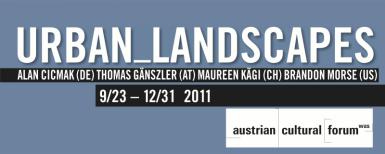URBAN_LANDSCAPES
Kulturforum Washington DC, 2011

About urban_landscapes
Opening Speech, Curator Silvie Aigner
The urban_landscapes exhibition conveys contemporary art themes that blend urbanity with the designs of landscape architecture and specimens of untouched nature. The pieces of art reflect the societal structure through their inclusion of architectural coincidences and urban derivatives as well as parks, gardens, yards, and avenues. Their exact topographic location is of minor importance; instead, nature and architecture are displayed as parts of a holistic concept. Reality as perceived by the artists forms the basis of their works, yet without exposing them through documentation. Instead, the abstract and inherent nature of the respective medium prevails.
In the works of Alan Cicmak, Thomas Gänszler, and Maureen Kägi, the landscape itself becomes a pre-determined piece of nature, part of the fabric of functional structures. In comparison, Brandon Morse employs continuously changing, biomorphic structures surrounded by black space. What these works have in common is the predominate use of black and white and their incorporation of surrounding spaces. The two-dimensional arts media (drawings, film clips, or photography) are transformed into installation art. Looking at the art scene in Austria, the object-oriented design of the art pieces crystallizes as a characteristic feature, a fact that is illustrated by this exhibition. In the works of Thomas Gänszler and Alan Cicmak, for instance, sculptures bear pictorial representations, and Maureen Kägi’s drawings are transformed into intensely spatial installations.
Another characteristic feature of the works on display here is that they never include the human body; emphasis lies solely with landscapes and the ways these can be incorporated into various artistic media. However, the curator’s intention was not to invite artists to work around a particular theme; rather, the selection was the result of the similarities of content and form between the works, with the goal of developing a controversial juxtaposition of the artists’ individual pieces. Furthermore, installations offer the opportunity to assemble objects and sculptures directly on site, taking into consideration the immediate local surroundings. They are confronted with the fact that the atrium of the Austrian Embassy is not only used for exhibitions but also often as a venue for different kinds of cultural events or concerts. The flexibility of the available space was an additional challenge for the artists, since their works thus had to be built as mobile and flexible objects.
When setting up and installing the works on site in collaboration with the artists, as the curator of the exhibition, I had the opportunity to take part in the individual steps of the process and the related discussions, which are special moments in our professional lives. This obviously requires artists to collaborate with the project’s partners, who are able to create the right conditions and surroundings and are willing to put their work space at the artists’ disposition.
A major goal of the exhibition series, in collaboration with the Austrian Cultural Forum Washington, is to promote networking activities among artists from Austria and Washington, D.C. and to foster collaborations with local galleries. During my stay in Washington, I have been able to make arrangements with Conner Contemporary Art to show works by one of their protégés at our gallery in Vienna. I am looking forward to presenting the work of U.S. artist Brandon Morse at the gallery bäckerstrasse4 - plattform für junge kunst in Vienna soon.
I would like to thank the Austrian Ambassador to the United States, Christian Prosl, as well as the Director General for Cultural Policy at the Austrian Federal Ministry for European and International Affairs, Ambassador Martin Eichtinger for their support on this project.
I also would like to express my thanks to the Director of the Austrian Cultural Forum Washington, Andrea Schrammel, for her spontaneous and enthusiastic invitation and follow-through, as well as for her courage to exhibit contemporary art, thus offering the artists the opportunity to reach an international audience. Furthermore, I would also like to thank Thomas Brandhuber for his outstanding support, and Leigh Connor, of Conner Contemporary Art, for putting at our disposal the works of Brandon Morse, whose pieces immediately fascinated me when I came across them during my first visit to the Katzen Arts Center at American University.
